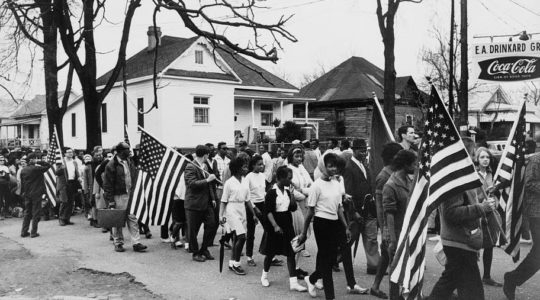Rep. James Traficant Jr. (D-Ohio) has accused the Justice Department’s Office of Special Investigations of throwing out two documents requested by convicted Nazi war criminal John Demjanjuk.
Such an act, Traficant says, would violate a federal judge’s order.
The OSI, which handles war crimes, denied the charge and claimed in turn that Demjanjuk’s supporters obtained copies of the documents in question without OSI approval, possibly by stealing them.
Demjanjuk, a retired Cleveland autoworker, was denaturalized in 1981 and extradited to Israel in 1986.
He was sentenced to death April 25, 1988, after being convicted a week earlier of being “Ivan the Terrible,” the man who operated the gas chambers at Treblinka, where an estimated 900,000 Jews died. The appeal is scheduled to be heard Nov. 1.
Edward Nishnic, Demjanjuk’s son-in-law, said he hopes that his father-in-law’s Israeli lawyer, Yoram Sheftel, will seek a delay of the appeal in November on the grounds that the OSI threw out crucial evidence.
The Justice Department’s Office of Professional Responsibility is currently investigating Traficant’s charge, as well as various charges contained in a 60-page memorandum from John Broadley, Nishnic’s lawyer.
The memos said to have been discarded were written after OSI’s 1979 interview with former Nazi prison guard Otto Horn in West Berlin.
One of the memos, written by OSI investigator Bernard Dougherty, was included in the record in Israel by Demjanjuk’s lawyers.
NOT INCLUDED IN TRIAL
The other memo, written by OSI historian George Garand, was not included in the record because Demjanjuk’s defense did not uncover it until after the trial, according to supporters of Demjanjuk.
Horn testified in Demjanjuk’s denaturalization hearing in 1979 that he identified “this Iwan” (sic) in the first set of photographs provided by OSI investigators who interviewed him.
But both memos state that Horn identified Demjanjuk only after being shown the photographs a second time. On the second showing, Demjanjuk’s picture was face up on top of the pile.
The OSI contends there would have been no substantial effect on Demjanjuk’s trial in Israel had the Garand memo been included in the record.
But in a press conference recently, Traficant claimed that OSI violated the law by not providing the memos to Demjanjuk’s defense, as mandated in April 1987 by Judge Louis Oberdorfer of the U.S. District Court for the District of Columbia.
Oberdorfer had upheld a Freedom of Information Act request filed by Nishnic, who is president and administrator of the John Demjanjuk Defense Fund. Oberdorfer’s order required OSI to provide all relevant documents on the case, with a few specified exceptions listed in an index.
The Dougherty and Garand memos were neither provided nor contained in the index.
John Demjanjuk Jr. told the Jewish Telegraphic Agency that “the OSI acted as if they (the memos) did not even exist.”
Neal Sher, OSI’s director, called the charges “an extralegal attempt to influence the courts,” but refused to comment further.
A well-placed department official said OSI does not throw out original documents and questioned how Demjanjuk’s defense legally obtained the two memos.
Traficant aides showed JTA the original copies of the documents, both of them in neat, unblemished condition.
Nishnic said the memos were found in the trash outside OSI’s former offices on K Street, which it vacated in May 1987.
Demjanjuk Jr. said the documents were initially leaked to him by two Washington-area people who recovered the garbage and who later revealed themselves to Demjanjuk’s defense team.
RESERVED FOR APPEAL
Nishnic said he has affidavits from them, but that they would not come forward until it is necessary to testify in court or before Congress that the documents were found in the trash.
When asked to provide the name of another original document found in the trash, to be cross-checked with OSI records, Nishnic refused, saying that would be reserved for the appeal.
He claimed that contained in the OSI trash were “boxes of unwrinkled paper,” such as the one that allegedly contained the Dougherty and Garand memos. OSI was “dumping entire files,” Nishnic said.
However, a box next to Traficant’s desk on Capitol Hill containing what the congressman said was OSI garbage contained no other original documents in condition comparable to the two unblemished memos. All documents in the box were torn into at least four parts.
Kalman Sultanik, a World Jewish Congress vice president, wrote to Traficant last week not only to complain about his accusations against OSI but to criticize the lawmaker’s comment at his press conference that Horn’s testimony was important because he was the only non-Jew to identify Demjanjuk.
“Your statement can only be read as suggesting that Jews (or is it only Jewish survivors of the Holocaust?) are inherently untrustworthy. This is bigotry, pure and simple, Congressman,” wrote Sultanik.
JEWISH TESTIMONY LESS CREDIBLE
A Traficant aide acknowledged his boss’ statement, but defended it by saying it is similar to a passage in a Feb. 19, 1986, memo by OSI trial attorney Bruce Einhorn.
That memo said that “the risk of reliance on testimony of Holocaust survivors… may be decreased by the use of corroborating evidence such as former Nazi collaborators like Horn.”
The aide added that his boss did not mean “to infer that he felt that Jewish testimony was any less credible.”
Traficant, in a letter he wrote July 26, has also asked Rep. Bruce Morrison (D-Conn.), chairman of the House Judiciary subcommittee on immigration, refugees and international law, to investigate the “practices and patterns of behavior” at the OSI.
Morrison has requested a report from OSI on Traficant’s allegations. He will wait until he receives the report before he proceeds any further, said Paul Donnelly, Morrison’s press liaison.
JTA has documented Jewish history in real-time for over a century. Keep our journalism strong by joining us in supporting independent, award-winning reporting.
The Archive of the Jewish Telegraphic Agency includes articles published from 1923 to 2008. Archive stories reflect the journalistic standards and practices of the time they were published.



